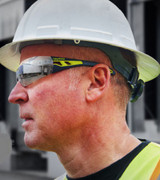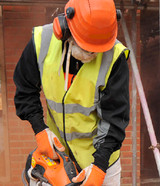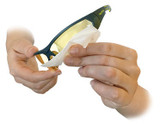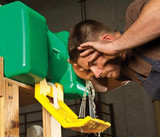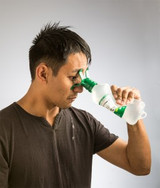Blog
Indoor/Outdoor and Changing Light Applications: What Kind of Lens Tint is Best for Your Safety Glasses?
Temporary blindness. Have you heard of it? Chances are, you’ve probably experienced it. Think of a time on the job when you’ve gone from inside a building to outside and it’s extremely sunny. The change forces you to squint while you wait for your pupils to constrict and properly adjust to the brightness. During this time, you’re temporarily unable to see. Do this several times in a day and your eyes start to become strained and fatigued. This is a recipe for eye irritability and headaches.
…
Jul 27th 2017
The Value of Wireless Alarms and Monitoring Systems on Emergency Equipment
By Samantha Hoch, Marketing, Haws
Federal safety regulations set forth by the Occupational Safety and Health Administration (OSHA) and The American National Standards Institute (ANSI) make the importance of safety equipment in potentially dangerous working environments clear. However, the stringent guidelines for emergency showers and eyewashes don’t extend to the inclusion of mandatory alarm and electronic monitoring systems on this equipment. This oversight can create unsafe working condi
…
Jun 29th 2017
Workplace Eye Injury Statistics - Don't Be One of Them
Think of the hundreds of times you've completed a task at work without eye protection, injury free. Perhaps the application doesn’t seem that hazardous, or maybe the safety glasses you have are uncomfortable, scratched up, or they fog too easily. Plus, you’re good at what you do. You've been doing this job for so long that being careful is second nature.
Until that one time when "being careful" wasn’t enough. It wasn't your fault. In fact, you did everything right. Unfortunately, the t
…
Jun 2nd 2017
How are Safety Glasses Supposed to Fit?
Simply wearing any old pair of safety eyewear isn’t enough to protect your eyes. Sure, it decreases the possibility of an injury, however, if your eyewear fits poorly or incorrectly, your putting yourself at a higher risk for injury.For too long, safety eyewear has been treated as “one size fits all.” Head and face shapes are so different, how is it possible to find one pair that works for everyone? It’s not. That’s why finding properly fitting eyewear is so crucial to wearability, especially wh
…
May 8th 2017
5 Easy Steps to Clean and Care for Your Safety Lenses
The number one reason for scratched lenses is improper cleaning. The second reason is poor handling and storage of safety eyewear.
It’s no surprise that the best way to make sure your eyewear is long lasting and high performing is through proper care, cleaning, and storage.
Take a moment to think about how you clean and care for your safety eyewear. Do you hold the lens to your shirt to rub it clean? Do you use a paper towel and regular soap to clean the lens? Or, do you (gasp!) u
…
Apr 7th 2017
ANSI Compliance, Safety and Health for Food Processing
By Samantha Hoch, Marketing, Haws Corp.
From the oil industry to mining, agriculture to research, any working environment that puts employees in close proximity to occupational hazards, such as potentially harmful chemicals, must make workplace safety a priority. The food processing, meatpacking, and poultry processing industries are no exception.
Industry Risks
In addition to physical hazards like high noise levels, cuts, and musculoskeletal disorders, exposure to substances like ammonia,
…
Feb 27th 2017
Addressing Occupational Safety for Locksmiths: Protective Equipment Must Haves
By Dusty Henry, Sevan Locks & Doors
When you consider occupational safety, there are a lot of different occupations that may come to mind first for needing protective equipment – construction workers, welders, etc. Being a locksmith can actually be rather hazardous work for your health as well. There is, of course, the inherent danger of dealing with going into a stranger’s home, business, or locked car. But there are even more dangers than this to consider. Protective e
…
Feb 24th 2017
How to Comply with Important Requirements for Eye Wash Stations
The ANSI/ISEA Z358.1-2014 American National Standard covers emergency eye/face washes, showers, and combination units. It is important to know that emergency showers are designed to flush the user's body, and should not be used to flush the eyes as the high water flow pressure can damage the eyes. Eye wash stations are designed to flush the eyes/face area only. Combination units contain both features: a shower and an eyewash station.
The main requirements for eyewash stations include pr
…
Feb 17th 2017
How to Get Your Eyes Protected at Work
Eye injuries are very common in a workplace. How do you protect your eyes? By wearing glasses, goggles, and face shields, depending on the type of work you are doing. Eyewear is important for safety because, according to the Bureau of Labor Statistics, three out of five accidents at work happened when the PPE was not worn at all or when the workers were wearing the wrong type of protection for the job. That is why it makes sense to consult a safety professional before making a purchase of eye
…
Dec 12th 2016
pH Neutral vs Saline Eyewash: When To Use
By Samantha Hoch, Marketing, Haws Corp.
Personal Emergency Eyewashes are for use when dust, dirt, chemicals and other contaminants come into contact with the eyes. With multiple solution options, you need to determine which is appropriate for the most effective rinse.
STEP 1: Determine Type of Substance (Foreign, acid, alkali, irritant)
STEP 2: Select Appropriate Fluid Type and Rinse (pH Neutralizer or Saline)
STEP 3: Continue Rinsing
STEP 4: Rinse as Directed (Duration)
It is import
…
Dec 5th 2016


